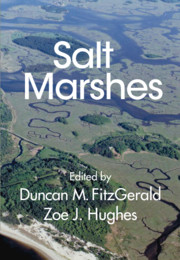Book contents
- Salt Marshes
- Salt Marshes
- Copyright page
- Contents
- Contributors
- Acknowledgments
- 1 State of Salt Marshes
- Part I Marsh Function
- 2 Salt Marsh Distribution, Vegetation, and Evolution
- 3 Salt Marsh Formation
- 4 Salt Marsh Hydrodynamics
- 5 Community Ecology of Salt Marshes
- 6 The Role of Marshes in Coastal Nutrient Dynamics and Loss
- Part II Marsh Dynamics
- Part III Marsh Response to Stress
- Index
- References
6 - The Role of Marshes in Coastal Nutrient Dynamics and Loss
from Part I - Marsh Function
Published online by Cambridge University Press: 19 June 2021
- Salt Marshes
- Salt Marshes
- Copyright page
- Contents
- Contributors
- Acknowledgments
- 1 State of Salt Marshes
- Part I Marsh Function
- 2 Salt Marsh Distribution, Vegetation, and Evolution
- 3 Salt Marsh Formation
- 4 Salt Marsh Hydrodynamics
- 5 Community Ecology of Salt Marshes
- 6 The Role of Marshes in Coastal Nutrient Dynamics and Loss
- Part II Marsh Dynamics
- Part III Marsh Response to Stress
- Index
- References
Summary
Sixty-five years ago, Teal’s (1962) study showed that salt marsh primary production was greater than community respiration. To explain this result, he suggested that marshes exported excess organic matter either directly as organic matter, or as organisms, to coastal waters. This concept, that marshes were “outwelling” material to the adjacent estuary and coastal oceans, was soon expanded to nutrients as well. However, the actual importance of the marsh in supplying organic matter and nutrients to adjacent coastal systems has been controversial and reviews debating the importance of outwelling from marshes have regularly appeared over the decades (Nixon 1980, Childers et al. 2000, Odum 2000, Valiela et al. 2000, Boynton and Nixon 2013). It has also been argued that in some cases the coastal ocean can act as a source of nutrients to the marsh and estuary (“inwelling”).
- Type
- Chapter
- Information
- Salt MarshesFunction, Dynamics, and Stresses, pp. 113 - 154Publisher: Cambridge University PressPrint publication year: 2021
References
- 2
- Cited by

